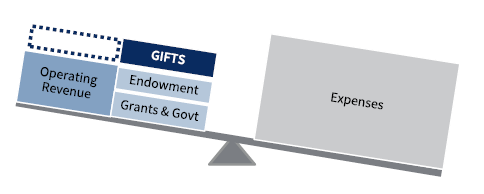Balancing the Financial Equation: Your Closest Supporters Have Never Been More Important
For non-profit institutions, the disruptions caused by the COVID-19 virus, and the speed by which these disruptions have materialized, create a perfect financial storm. Unlike prior financial downturns, we are experiencing a health crisis that has abruptly closed institutions whose missions depend on the public showing up. Few institutions are immune: schools, colleges & universities, hospitals, museums, gardens, orchestras, ballet and other performing arts organizations, operas, and zoos, among others. Closures of these institutions have led to lost revenues, climbing expenses, and near-term cash flow conditions that are more challenging than any pre-crisis stress tests might have predicted.
The financial equations of nonprofit institutions have been thrown out of balance.
Time is working against operational survival. Vulnerable institutions are depleting cash reserves, spending from their endowment, and increasing their debt load to fill unexpected operating deficits. Without other infusions of financial support, balance sheets will weaken and make recovery more challenging and prolonged. Significant gifts today have the power to provide a clearer path for institutions to “close the operating gap,” so an institution can focus on its long-term recovery. Donors have always been key to the financial health of nonprofit institutions, but now they are more important than ever.
Here are the action steps that Endowment and Foundation leaders can take to maintain valued relationships, and connect supporters to the immediate challenge facing these institutions.
- Communicate, communicate, communicate. An institution’s closest supporters are essential partners, especially during this financial challenge. Don’t lose them. Well run, high functioning institutions communicate in good times and bad. Now they are reaching out to donors and stakeholders. The first question is: how are you doing? If the conversation turns back to the institution, be prepared to deliver honest, candid reports about the institution’s financial health—what is known about the impact on people, mission, assets, and what is knowable about the future. Honesty also means being clear about what you do not know and what is still uncertain.Stakeholders should be hearing from the places they care about. If they don’t, they may assume that institutions are not in immediate need of support, or more drastically, that an institution may be going out of business. A lack of communication creates a void and exacerbates the financial uncertainty for the institution.
- Be prepared for the question “What’s the plan?” Specific needs may have drastically changed from a few weeks ago. Priorities may have shifted from the new building wing to preserving collections, or from international education to food security. More than ever it is important to explain how donations support current efforts, align with mission, and enable long-term sustainability.While we don’t know how long disruptions will be felt, best practices involve scenario planning to illustrate the myriad of financial outcomes for an institution. Planning also frames strategies to survive the current crisis and be positioned for a recovery. Donors are more than financial backers, they are also key advisors. They need to be included in the planning process and understand the near-term and the long-term impact of their philanthropy. Gauge the donor’s capacity in the moment and know your response when asked how they can help the institution recover.
- Land on Hope. While this crisis can be daunting, organizations and their supporters have the power to address it, most immediately by balancing the financial equation and surviving. There is hope in working together, plugging into the current needs and ensuring that important organizations continue to deliver missions that are more important than ever.
Balancing the financial equation over the near term may be daunting. A perfect storm has materialized to challenge institutions to a degree that hasn’t been experienced before. Yet financial disruptions may provide an institution an opportunity to work closely with its greatest supporters to rebalance its financial equation. Supportive and financially inclined donors may provide crucial ballast to enable an institution to thrive for years to come.
Margaret Chen, Global Head of Endowment & Foundation Practice
Tracy Abedon Filosa, Head of CA Institute


